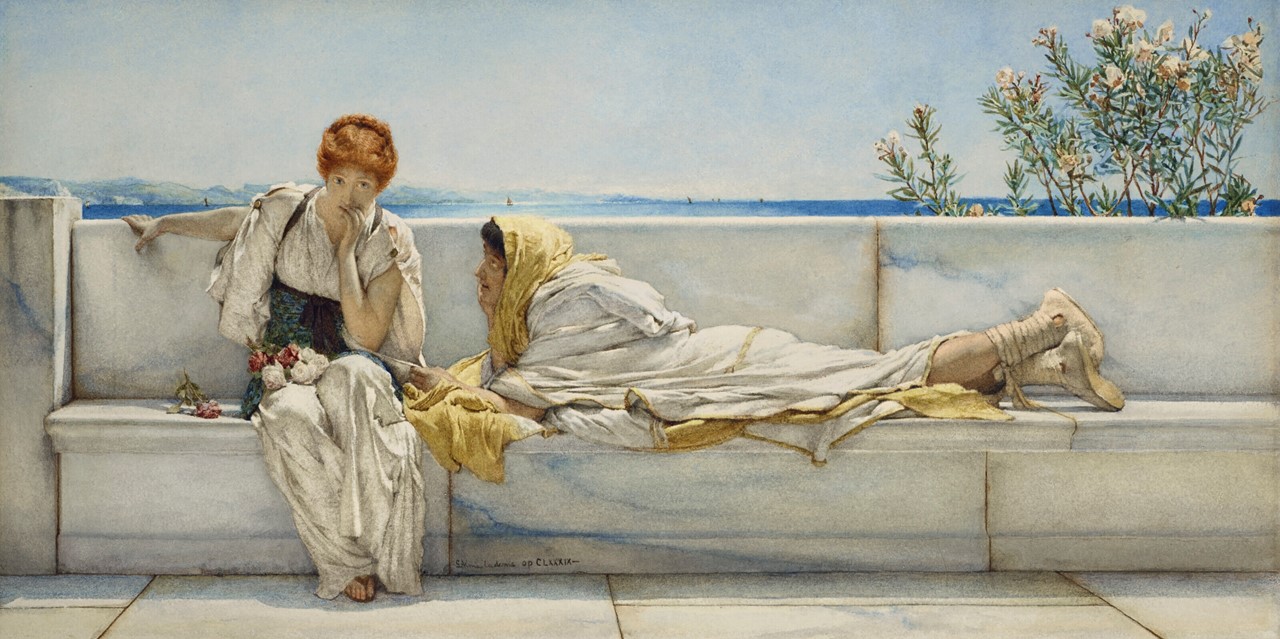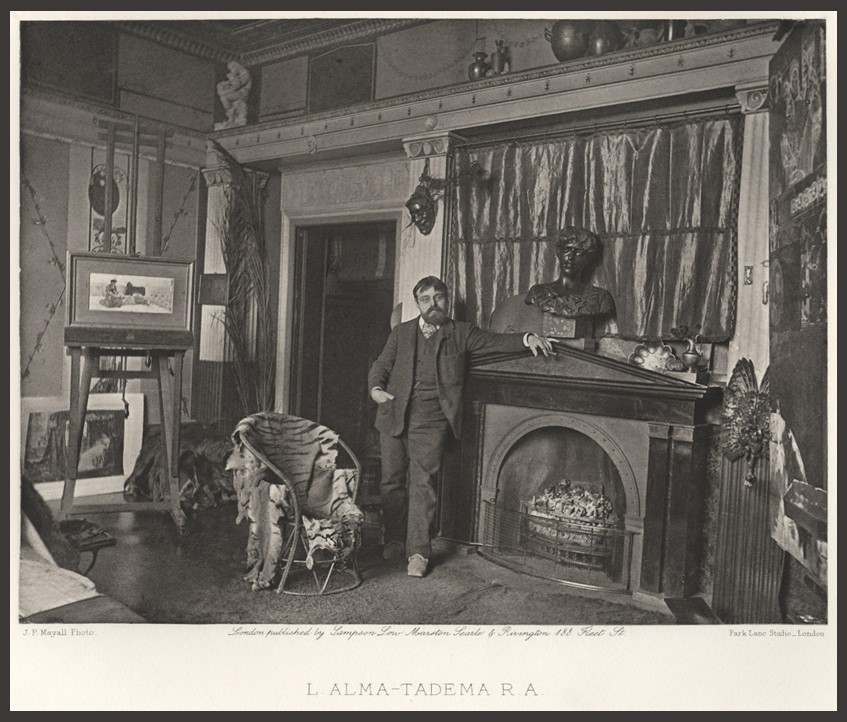
A Solicitation, 1878, pencil and watercolour on paper, 22.9 x 45.1 cm, Private Collection https://www.mutualart.com/Artwork/A-Solicitation/8FB915CF2DFA260B4CC9A753186F8298
On Saint Valentine’s Day, I think of Sir Lawrence Alma-Tadema and Romantic Love. I think of his many paintings portraying the emotional nuances of romantic interactions, the courtship scenes with a heightened sense of intimacy, the use of rich colors and the exquisite settings often applied to evoke a romantic ambiance. I reflect upon his gentle gestures, unambiguous glances, and subtle expressions that capture the essence of romantic relationships in a bygone era. Alma-Tadema’s paintings, whether set in ancient Rome, Greece, or other historical periods, convey a sense of timeless beauty and the universal aspects of love and courtship. The artist’s ability to infuse his works with a sense of elegance and emotion allowed viewers to connect with the theme of courtship on a deeply human level, transcending the specific historical context of each painting. Sir Lawrence Alma-Tadema was a master in representing Romantic Love!
On the 13th of December 2022, a small watercolour painting by Alma-Tadema, titled A Solicitation, was auctioned at Christie’s, with great success. The composition is entirely typical of his work, with a young woman sitting upright on a marble bench, listening to the entreaties of the young man who reclines beside her. Is she swayed by his ‘words? I do not know… I see her holding on to her lap the flowers ‘he’ probably gave her contemplating his ‘proposition’. https://www.christies.com/lot/lot-6408828?ldp_breadcrumb=back&intObjectID=6408828&from=salessummary&lid=1
The painting A Solicitation has all the characteristics of the Sir Lawrence Alma-Tadema artistic style. Renowned for his expertise in portraying various facets of sun-soaked, glowing marble, the artist, for example, presents a large, almost luminescent bench to the viewer, by skillfully utilizing watercolour transparency to evoke the hues of the marble. Equally interesting is how the depicted young couple, dressed in off-white clothes, stands out, due to Alma-Tadema’s adept handling of different textures. Finally, it is essential to mention the Mediterranean oleander tree in the right part of the middle ground, which the artist used to harmonize the rectangular shape of the composition, and the blue hues of the sea and distant coast in the background that seamlessly merge with the bright sky, creating a splendid morning scene. https://www.christies.com/lot/lot-6408828?ldp_breadcrumb=back&intObjectID=6408828&from=salessummary&lid=1
Alma-Tadema’s patrons were captivated by the romantically appealing compositions depicting courtship, prompting the artist to create multiple versions of this theme. The inaugural scene, titled “Pleading,” was crafted in 1876 and is currently housed in the Guildhall Art Gallery in London. Following this, in approximately 1877, Alma-Tadema produced another courtship scene titled “The Question,” now part of the Colección Pérez Simón in Mexico City. The third installment in this series is the watercolor painting from 1878, named “A Solicitation.” Subsequently, three additional paintings, dating back to 1883, are dispersed across prominent locations—the British Museum (Op. CCLVIII), a private collection, and the Walters Art Museum in the United States (Op. CCLIX). Throughout these various iterations of the courtship composition, Alma-Tadema maintained a consistent portrayal of the fundamental relationship between the two figures: a contemplative female and a beseeching, submissive male gazing up at her. The compositions also feature an expansive, almost panoramic view extending beyond the edge of the bench, revealing the vast sea and its miniature sailing boats. https://www.christies.com/lot/lot-6408828?ldp_breadcrumb=back&intObjectID=6408828&from=salessummary&lid=1

Sir Lawrence Alma-Tadema (1836–1912) was a renowned Dutch-born Victorian painter who achieved international acclaim for his vivid and meticulously detailed depictions of classical antiquity. Known for his mastery of historical accuracy and meticulous attention to architectural and ornamental details, Alma-Tadema’s paintings often showcased scenes from ancient Rome, Greece, and Egypt. His works, characterized by their sumptuous colors, intricate compositions, and a focus on the opulent lifestyles of the classical world, captivated audiences during the late 19th and early 20th centuries. Alma-Tadema’s artistic contributions left an enduring impact on the academic art scene, and his legacy continues to be celebrated for the way he brought ancient history to life through his extraordinary talent and dedication to historical accuracy.
For a PowerPoint Presentation of six paintings by Sir Lawrence Alma-Tadema, presenting Courtship Scenes, please… Check HERE!